
Montevideo is the capital and largest city of Uruguay. According to the 2011 census, the city proper has a population of 1,319,108 in an area of 201 square kilometers (78 sq mi). Montevideo is situated on the southern coast of the country, on the northeastern bank of the Río de la Plata.
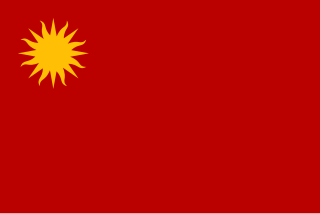
The Colorado Party is a liberal political party in Uruguay.

Julio María Sanguinetti Coirolo is a Uruguayan lawyer, journalist and politician of the Colorado Party (PC) who twice served as President of Uruguay from 1985 to 1990, and from 1995 to 2000. He was the first democratically elected president after twelve years of military dictatorship.

Gregorio Conrado Álvarez Armelino, also known as El Goyo, was an Uruguayan Army general who served as president of Uruguay from 1981 until 1985 and was the last surviving president of the civic-military dictatorship.

Juan Pedro Bordaberry Herrán is a Uruguayan attorney, lecturer, and politician, who served as a Senator of the Republic from 2010 to 2020, as Minister of Tourism and Sports from 2003 to 2005, and as Minister of Industry, Energy and Mining from 2002 to 2003. A member of the Colorado Party, he was the party's candidate for president in the 2009 and 2014 presidential elections.

Danilo Ángel Astori Saragosa was a Uruguayan social democratic politician who served as the 15th vice president of Uruguay from 2010 to 2015 under President José Mujica. A member of Uruguay Assembly–Broad Front, he also served as Minister of Economy and Finance from 2005 to 2008 and from 2015 to 2020, and as Senator of the Republic from 1990 to 2005.
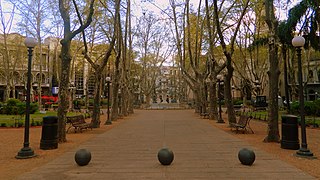
Plaza de la Constitución, also known as Plaza Matriz, is the oldest city square in Montevideo, Uruguay.

The Obelisk of Montevideo, officially Obelisk to the Constituents of 1830 is a monument created by sculptor José Luis Zorrilla de San Martín (1891-1975). It is a three-sided obelisk made of granite, 40 metres (130 ft) tall with three bronze statues on its sides, representing "Law", "Liberty" and "Force". It has a hexagonal water fountain around it with six spheres on its outer circumference. It is located at the intersection of 18 de Julio and Artigas Boulevard avenues, in Montevideo, at the entrance of the Parque Batlle area. It was built in 1930 to celebrate the 100th anniversary of the first Constitution of Uruguay and is an homage to the participants of the General Assembly of the first Constitution.

The following outline is provided as an overview of and topical guide to Uruguay:
Villanueva Saravia Pinto was a Uruguayan politician of the National Party, who served as intendant of Cerro Largo Department from 1995 to 1998.

Gabriel Gurméndez Armand-Ugon is a Uruguayan industrial engineer, business executive and politician of the Colorado Party (PC), who served as president of the National Administration of Telecommunications from 2020 to 2023, and as Minister of Transport and Public Works in 2004.
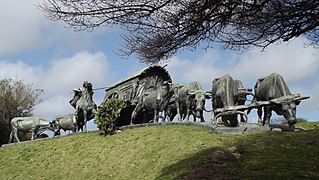
Parque Batlle, formerly Parque de los Aliados, is a barrio and a major public central park in Montevideo, Uruguay. It is named in honour of José Batlle y Ordóñez, President of Uruguay from 1903-1907 and 1911–1915.

Punta Carretas is a barrio of Montevideo, Uruguay.

The civic-military dictatorship of Uruguay (1973–85), also known as the Uruguayan Dictatorship, was an authoritarian military dictatorship that ruled Uruguay for 12 years, from June 27, 1973 until March 1, 1985. The dictatorship has been the subject of much controversy due to its violations of human rights, use of torture, and the unexplained disappearances of many Uruguayans. The term "civic-military" refers to the military regime's relatively gradual usurpation of power from civilian presidents who continued to serve as head of state, which distinguished it from dictatorships in other South American countries in which senior military officers immediately seized power and directly served as head of state.
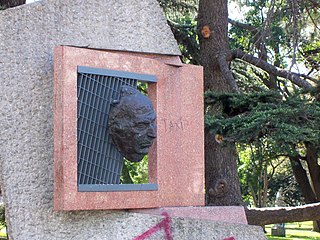
Alberto Candeau was a famous Uruguayan actor and writer.
Nibia Sabalsagaray was an Uruguayan educator and activist. She was tortured and killed by the civic-military dictatorship that ruled between 1973 and 1985.

Wilson Ferreira Aldunate (1919–1988) was a Uruguayan politician and a historically important member of the National Party.

Antonio Marchesano was a Uruguayan lawyer and politician.

Javier Fernando García Duchini is a Uruguayan physician and politician of the National Party, currently serving as Minister of National Defense since 1 March 2020. García was elected as a representative on several occasions in 1994, 2004, and 2009. In 2014, García was elected Senator.
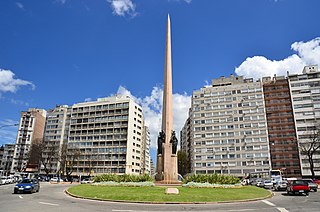
The 1983 Uruguayan pro-democracy demonstration, known as Acto del Obelisco was a massive demonstration held at the Obelisk of the Constituents, Montevideo, Uruguay, on November 27, 1983. The objective of the act was to demand the end of the civil-military dictatorship and the holding of democratic elections. At the event, the only speaker, actor Alberto Candeau, read the proclamation, in which he called for a democratic transition.

















